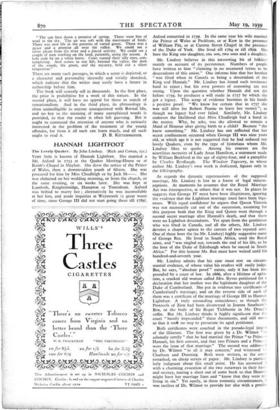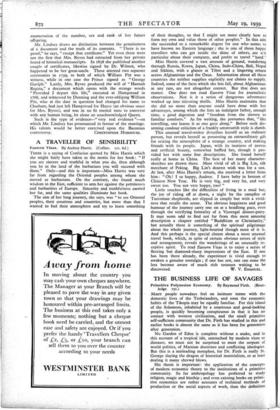HANNAH LIGHTFOOT
The Lovely Quaker. By John Lindsey. (Rich and Cowan, ifs.) VERY little is known of Hannah Lightfoot. She married a Mr. Axford in 1753 at the Quaker Meeting-House or at Keith's Chapel in Mayfair. She drew the notice of the Prince of Wales, then a downtrodden youth of fifteen. She was procured for him by Miss Chudleigh or by Jack M—. She was abducted on her wedding morning, or from the church, or the same evening, or six weeks later. She was kept at Lambeth, Knightsbridge, Hampton or Tottenham. Axford was bribed to marry her ; alternatively he was inconsolable at her loss, and made inquiries at Weymouth (a great waste of time, since George III did not start going there till 1789).
Axford remarried in 1759. In the same year his wife married the Prince of Wales at Peckham, or at Kew in the presence of William Pitt, or at Curzon Street Chapel in the presence of the Duke of York. She lived till 1764 or till 1829. She bore the King one daughter, one son, two sons and a daughter.
Mr. Lindsey believes in this interesting bit of folklore mainly on account of its persistence. Numbers of people have written to him "claiming in no measured terms to be descendants of this union." One informs him that her brother "was feted when in Canada as being a descendant of the King and Hannah." Mr. Lindsey has found such testimony hard to reject ; but his own powers of reasoning are not strong. Upon the question whether Hannah did not die before 1759, he produces a will made in 1757 by which she got a legacy. This scrap of evidence becomes in his hands a positive proof. "We know for certain that in 1757 she was still alive for Robert Pearne to leave her money "; as though no legacy had ever failed. Similarly, Mr. Lindsey endorses the likelihood that Miss Chudleigh had a hand in the matter. Why, he asks, was she allowed to remain a Maid of Honour after giving birth to a child? Because "she knew something." Mr. Lindsey has not reflected that her secret confinement odcurred when George III was nine years old, at which age it is not suggested that he had seduced any lovely Quakers, even by the type of historians whom Mr. Lindsey likes to quote. Among his sources are the scurrilous memoirs of Lady Anne Hamilton, a statement made by William Beckford at the age of eighty-four, and a pamphlet by Charles Bradlaugh. The Windsor Tapestry, to whose author Mr. Lindsey's own work is dedicated, figures only in the bibliography.
As regards the dynastic repercussions of the supposed marriage, Mr. Lindsey is lost in a forest of legal miscon- ceptions. At moments he assumes that the Royal Marriage Act was retrospective, at others that it was not. In places he suggests that George IV must have been illegitimate, ignoring the evidence that the Lightfoot marriage must have been biga- mous. With equal confidence he argues that Queen Victoria was not necessarily cut out of the succession, assuming for this purpose both that the King and Queen went through a second secret marriage after Hannah's death, and that there were no Lightfoot descendants. Yet apart from the gentleman who was feted in Canada, and all the others, Mr. Lindsey devotes a chapter apiece to the careers of two reputed sons. One of these bore the (to Mr. Lindsey) highly suggestive name of George Rex. He lived in South Africa, used the Royal arms, and "was singled out, towards the end of his life, to be the host of the Duke of Edinburgh when he stayed in South Africa." For this honour Mr. Rex must have waited until his hundred-and-seventh year.
Mr. Lindsey admits that his case must rest on circum- stantial evidence, of whose value his readers will easily judge.
But, he says, "absolute proof" exists; only it has been im- pounded by a court of law. In 1866, after a lifetime of agita- tion, a cracked old woman called Mrs. Ryves petitioned for a
declaration that her mother was the legitimate daughter of the Duke of Cumberland. She put in evidence two certificates of Cumberland's marriage; and on the reverse side of each of them was a certificate of the marriage of George III to Hannah Lightfoot. A truly astounding coincidence; as though th Protocols of Zion had been discovered in Joanna Southcon', Box, or the body of Sir Roger Tichborne in Mr. Druce's coffin. But Mr. Lindsey thinks it highly significant that tl court "hastily impounded" these documents, and still mo so that it took no step to prosecute its aged petitioner.
Both certificates were couched in the pseudo-legal jarg( 1 of the illiterate. The first was given by a Dr. Wilmot "t' solemnly certify" that he had married the Prince "to Prince,, Hannah, his first consort, and that two Princes and a Princoi were the issue of that marriage." The second was addrest by Dr. Wilmot "to all it may concern," and witnessed ' Chatham and Dunning. Both were written, as the cot. ' remarked, on cheap scraps of paper. Mr. Lindsey is partic, larly indignant about this small point. He has answered with a charming evocation of the two runaways in their hasi,' and secrecy, tearing a sheet out of some book so that Hanna , might have her marriage lines and "know that they were n( living in sin." Yet surely, in these romantic circumstances, was tactless of Dr. Wilmot to provide her also with a precis,:
enumeration of the number, sex and rank of her future offspring.
Mr. Lindsey draws no distinction between the genuineness of a document and the truth of its contents. "There is no proof," he says, "except that certificate." Yet even these were not the first that Mrs. Ryves had extracted from her private hoard of historical manuscripts. In 1858 she published another couple of certificates, likewise signed by Dr. Wilmot, who happened to be her great-uncle. These attested two separate ceremonies in 1759, to both of which William Pitt was a witness, while in one case the Prince signed as "George Guelph." Lastly, Mrs. Ryves produced the will of "Hannah Regina," a document which opens with the strange words "Provided I depart this life," executed at Hampstead in 1768, and witnessed by Dunning and the ever-obliging William Pitt, who at the date in question had changed his name to Chatham, had just left Hampstead for Hayes (an obvious snare for Mrs. Ryves), and was in no fit mental state to converse with any human being, let alone an unacknowledged Queen.
Such is the type of evidence—" very real evidence "—on which Mr. Lindsey has pronounced in favour of the marriage. His talents would be better exercised upon the Baconian



















































 Previous page
Previous page